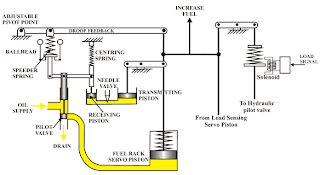Using a sketch to illustrate your answer, describe a suitable governor.
Give an account of the governor action to increase the power delivered by the engine in response to a large electrical load increase while also restoring and maintaining the correct frequency.
Explain each of the following:
i) the necessity for droop;
ii) how droop is effected.
a.

The sketch shows the principle of a hydraulic governor with feedback designed to return the engine to the set speed after a load change (isochronous).
A rotating ballhead driven from the engine and therefore proportional to engine speed operates a pilot valve to supply or drain oil from the underside of a fuel rack servo piston which is linked to the fuel rack. The movement of the ballhead is opposed by an adjustable speeder spring.
A floating link between the pilot valve, receiving piston and ballhead assembly means that for equilibrium with the pilot valve shut, the ballhead weights must always be in the same position (i.e. the engine must always be running at the same speed).
The governor also incorporates a load sensing arrangement for fast response in the event of a large change in electrical load
Provision is made for adjustable droop feedback which alters the compression on the speeder spring.
b.
Due to flywheel effect, and the response time of the hydraulic governor (viscosity of oil, friction) there will be a delay between the increase in load and the governor responding to the drop in speed. However the load sensing side of the governor will give a greater control of the speed with higher sensitivity and little droop.
When the load increases, the load sensing side of the governor will increase the fuel racks before the engine slows down. The speed sensing side of the governor fine tunes any small deviation in the speed of the engine.
The speed sensing side works as described below:
With an increase in load the engine slows down, The balls move inwards and the control valve moves downwards allowing oil to flow to the underside of the power piston, moving it upwards and increasing the fuel.
The transmitting piston moves downwards, increasing the pressure in the feedback system, moving the receiving piston upwards against the spring pressure, and shutting the pilot valve.
If there were no leakage in this feedback hydraulic system, then the result would be a permanent speed droop. However because oil is allowed to leak to a reservoir through a needle valve, the centering spring returns the receiving piston back to its original position, meaning the ballhead must be spinning at its original speed. Because the frequency is proportional to the engine speed, the frequency must be the same as it was before the load change.
c.
i)
Droop can be expressed as:
(no load speed - full load speed) / full load speed
When alternators are operated in parallel they must be fitted with governors which have a small amount of adjustable positive droop (i.e. the engine slows down slightly as the load is increased) so that they can load share equally.
If the governors were purely isochronous, then when trying to load share, the faster running machine would tend to take all the load.
ii)
With reference to the sketch in part (a) a linkage connected to the output of the governor moves about an adjustable pivot. As the output moves to put more fuel on the engine as a result of a load increase, the droop linkage reduces the compression of the speeder spring, thus reducing the speed of the engine.
No comments:
Post a Comment